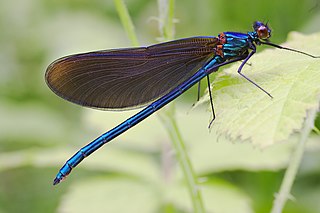
The Calopterygidae are a family of damselflies, in the suborder Zygoptera. They are commonly known as the broad-winged damselflies, demoiselles, or jewelwings. These rather large damselflies have wingspans of 50–80 mm, are often metallic-coloured, and can be differentiated from other damselflies by the broader connection between the wings and the body, as opposed to the abrupt narrowing seen in other damselfly families. The family contains some 150 species.

Thaumatoneuridae is a family of damselflies in the order Odonata. There are at least three genera and about five described species in Thaumatoneuridae.

Atrocalopteryx is a genus of damselflies belonging to the family Calopterygidae. It was established in 2005 during a phylogenetic study of the family, and its definition is still unclear.

Calopterygoidea is a superfamily of damselflies in the order Odonata.
Lestes simplex is a species of spreadwing in the damselfly family Lestidae. It is found in Central America.
Indolestes alfurus is a species of spreadwing in the damselfly family Lestidae.
Indolestes bilineatus is a species of spreadwing in the damselfly family Lestidae.
Indolestes cheesmanae is a species of spreadwing in the damselfly family Lestidae.

Calopteryginae is a subfamily of broad-winged damselflies in the family Calopterygidae. There are about 17 genera and more than 160 described species in Calopteryginae.

Calocypha is a genus of jewel damselfly in the family Chlorocyphidae. There are at least two described species in Calocypha.
Atrocalopteryx atrocyana is a species of broad-winged damselfly in the family Calopterygidae.
Atrocalopteryx coomani is a species of broad-winged damselfly in the family Calopterygidae.
Atrocalopteryx laosica is a species of broad-winged damselfly in the family Calopterygidae.
Atrocalopteryx melli is a species of broad-winged damselfly in the family Calopterygidae.
Atrocalopteryx oberthueri is a species of broad-winged damselfly in the family Calopterygidae.
Allocnemis abbotti, formerly Chlorocnemis abbotti, is a species of white-legged damselfly in the family Platycnemididae. It is found in Kenya, Malawi, and Tanzania. Its natural habitats are subtropical or tropical moist lowland forests, rivers, intermittent rivers, and freshwater springs. It is threatened by habitat loss.
Allocnemis montana, formerly Chlorocnemis montana, is a species of white-legged damselfly in the family Platycnemididae. It is found in Malawi and Tanzania. Its natural habitats are rivers and freshwater springs.
Allocnemis pauli is a species of white-legged damselfly in the family Platycnemididae. It is found in the Democratic Republic of the Congo, Kenya, Nigeria, and Uganda. Its natural habitats are subtropical or tropical moist lowland forests, rivers, intermittent rivers, and freshwater springs.
Mecistogaster amazonica is a species of narrow-winged damselfly in the family Coenagrionidae.

Allocnemidinae is a subfamily of damselflies in the family Platycnemididae. There are 5 genera in Allocnemidinae, found in Africa and Arabia.






